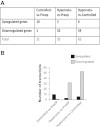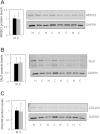Controlled reoxygenation cardiopulmonary bypass is associated with reduced transcriptomic changes in cyanotic tetralogy of Fallot patients undergoing surgery
- PMID: 22991208
- PMCID: PMC3524652
- DOI: 10.1152/physiolgenomics.00072.2012
Controlled reoxygenation cardiopulmonary bypass is associated with reduced transcriptomic changes in cyanotic tetralogy of Fallot patients undergoing surgery
Abstract
In cyanotic patients undergoing repair of heart defects, high level of oxygen during cardiopulmonary bypass (CPB) leads to greater susceptibility to myocardial ischemia and reoxygenation injury. This study investigates the effects of controlled reoxygenation CPB on gene expression changes in cyanotic hearts of patients undergoing surgical correction of tetralogy of Fallot (TOF). We randomized 49 cyanotic TOF patients undergoing corrective cardiac surgery to receive either controlled reoxygenation or hyperoxic/standard CPB. Ventricular myocardium biopsies were obtained immediately after starting and before discontinuing CPB. Microarray analyses were performed on samples, and array results validated with real-time PCR. Gene expression profiles before and after hyperoxic/standard CPB revealed 35 differentially expressed genes with three upregulated and 32 downregulated. Upregulated genes included two E3 Ubiquitin ligases. The products of downregulated genes included intracellular signaling kinases, metabolic process proteins, and transport factors. In contrast, gene expression profiles before and after controlled reoxygenation CPB revealed only 11 differentially expressed genes with 10 upregulated including extracellular matrix proteins, transport factors, and one downregulated. The comparison of gene expression following hyperoxic/standard vs. controlled reoxygenation CPB revealed 59 differentially expressed genes, with six upregulated and 53 downregulated. Upregulated genes included PDE1A, MOSC1, and CRIP3. Downregulated genes functionally clustered into four major classes: extracellular matrix/cell adhesion, transcription, transport, and cellular metabolic process. This study provides direct evidence that hyperoxic CPB decreases the adaptation and remodeling capacity in cyanotic patients undergoing TOF repair. This simple CPB strategy of controlled reoxygenation reduced the number of genes whose expression was altered following hyperoxic/standard CPB.
Figures




Similar articles
-
Effect of cardiopulmonary bypass reoxygenation on myocardial dysfunction following pediatric tetralogy of Fallot repair.BMC Cardiovasc Disord. 2021 Apr 26;21(1):210. doi: 10.1186/s12872-021-02033-2. BMC Cardiovasc Disord. 2021. PMID: 33902450 Free PMC article.
-
Transcriptomic analysis of patients with tetralogy of Fallot reveals the effect of chronic hypoxia on myocardial gene expression.J Thorac Cardiovasc Surg. 2010 Aug;140(2):337-345.e26. doi: 10.1016/j.jtcvs.2009.12.055. Epub 2010 Apr 22. J Thorac Cardiovasc Surg. 2010. PMID: 20416888 Free PMC article.
-
Surgical reoxygenation injury of the myocardium in cyanotic patients: clinical relevance and therapeutic strategies by normoxic management during cardiopulmonary bypass.Gen Thorac Cardiovasc Surg. 2012 Sep;60(9):549-56. doi: 10.1007/s11748-012-0115-2. Epub 2012 Jul 11. Gen Thorac Cardiovasc Surg. 2012. PMID: 22782441 Review.
-
Uncontrolled reoxygenation by initiating cardiopulmonary bypass is associated with higher protein S100 in cyanotic versus acyanotic patients.Thorac Cardiovasc Surg. 2000 Oct;48(5):263-8. doi: 10.1055/s-2000-7879. Thorac Cardiovasc Surg. 2000. PMID: 11100757
-
Myocardial protection in hypoxic immature hearts.Thorac Cardiovasc Surg. 2000 Feb;48(1):46-54. doi: 10.1055/s-2000-12142. Thorac Cardiovasc Surg. 2000. PMID: 10757161 Review.
Cited by
-
Intermittent antegrade warm-blood versus cold-blood cardioplegia in children undergoing open heart surgery: a protocol for a randomised controlled study (Thermic-3).BMJ Open. 2020 Oct 14;10(10):e036974. doi: 10.1136/bmjopen-2020-036974. BMJ Open. 2020. PMID: 33055113 Free PMC article.
-
Effect of cardiopulmonary bypass reoxygenation on myocardial dysfunction following pediatric tetralogy of Fallot repair.BMC Cardiovasc Disord. 2021 Apr 26;21(1):210. doi: 10.1186/s12872-021-02033-2. BMC Cardiovasc Disord. 2021. PMID: 33902450 Free PMC article.
-
Derivation and Validation of a Nomogram to Predict In-Hospital Complications in Children with Tetralogy of Fallot Repaired at an Older Age.J Am Heart Assoc. 2019 Nov 5;8(21):e013388. doi: 10.1161/JAHA.119.013388. Epub 2019 Oct 24. J Am Heart Assoc. 2019. PMID: 31645167 Free PMC article.
-
Normoxic and hyperoxic cardiopulmonary bypass in congenital heart disease.Biomed Res Int. 2014;2014:678268. doi: 10.1155/2014/678268. Epub 2014 Sep 18. Biomed Res Int. 2014. PMID: 25328889 Free PMC article.
-
Nitrite reductase and nitric-oxide synthase activity of the mitochondrial molybdopterin enzymes mARC1 and mARC2.J Biol Chem. 2014 Apr 11;289(15):10345-10358. doi: 10.1074/jbc.M114.555177. Epub 2014 Feb 5. J Biol Chem. 2014. PMID: 24500710 Free PMC article.
References
-
- Allen BS, Rahman S, Ilbawi MN, Kronon M, Bolling KS, Halldorsson AO, Feinberg H. Detrimental effects of cardiopulmonary bypass in cyanotic infants: preventing the reoxygenation injury. Ann Thorac Surg 64: 1381–1387, 1997 - PubMed
-
- Ashburner M, Ball CA, Blake JA, Botstein D, Butler H, Cherry JM, Davis AP, Dolinski K, Dwight SS, Eppig JT, Harris MA, Hill DP, Issel-Tarver L, Kasarskis A, Lewis S, Matese JC, Richardson JE, Ringwald M, Rubin GM, Sherlock G. Gene ontology: tool for the unification of biology. The Gene Ontology Consortium. Nat Genet 25: 25–29, 2000 - PMC - PubMed
-
- Blasig IE, Grune T, Schonheit K, Rohde E, Jakstadt M, Haseloff RF, Siems WG. 4-Hydroxynonenal, a novel indicator of lipid peroxidation for reperfusion injury of the myocardium. Am J Physiol Heart Circ Physiol 269: H14–H22, 1995 - PubMed
-
- Bulutcu FS, Bayindir O, Polat B, Yalcin Y, oZbek U, Cakali E. Does normoxemic cardiopulmonary bypass prevent myocardial reoxygenation injury in cyanotic children? J Cardiothorac Vasc Anesth 16: 330–333, 2002 - PubMed
-
- Caputo M, Mokhtari A, Rogers CA, Panayiotou N, Chen Q, Ghorbel MT, Angelini GD, Parry AJ. The effects of normoxic versus hyperoxic cardiopulmonary bypass on oxidative stress and inflammatory response in cyanotic pediatric patients undergoing open cardiac surgery: a randomized controlled trial. J Thorac Cardiovasc Surg 138: 206–214, 2009 - PMC - PubMed
Publication types
MeSH terms
Substances
Grants and funding
LinkOut - more resources
Full Text Sources
Molecular Biology Databases

